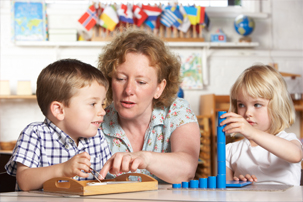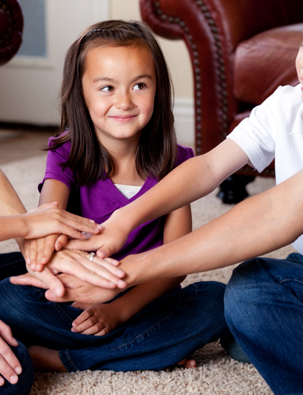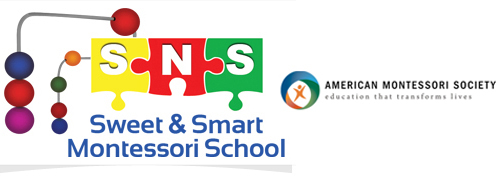(Frequently Asked Questions)
General Questions
 Q. Where did Montessori come from?
Q. Where did Montessori come from?
A. Montessori System was introduced in 1907 by Dr. Maria Montessori, the first woman in Italy to become a physician. She based her educational methods on scientific observation of children’s learning processes. Guided by her discovery that children teach themselves, Dr. Montessori designed a “prepared environment” in which children could freely choose from a number of developmentally appropriate activities. Now, nearly a century after Maria Montessori’s first “Casa dei Bambini (“children’s house”) in Rome, Montessori education is found all over the world, spanning ages from birth to adolescence.
Q. What is the difference between Montessori and traditional education?
A. At the under age six level, Montessori emphasizes learning through all five senses, not just through listening, watching, or reading. Children in Montessori classes learn at their own, individual pace and according to their own choice of activities from hundreds of possibilities. The are not required to sit and listen to a teacher talk to them as a group, but are engaged in individual or group activities of their own, with materials that have been introduced to them 1:1 by the teacher who knows what each child is ready to do. Learning is an exciting process of discovery, leading to concentration, motivation, self-discipline, and a love of learning.
Montessori classes place children in multiple age groups, forming communities in which the older children spontaneously share their knowledge with the younger ones. Montessori represents an entirely different approach to education.
Q. Can I do Montessori at home with my child?
A. Yes, you can use Montessori principles of child development at home. To familiarize yourself become a volunteer at a Montessori school. Look at your home through your child’s eyes. Children need a sense of belonging, and they get it by participating fully in the routines of everyday life. “Help me do it by myself” is the life theme of the preschooler, school age child, teenager, and young adult.
In school, only a trained Montessori teacher can properly implement Montessori education with the specialized learning equipment taught during teacher training, but there are many ideas that can be used in the home to further support the skills developed at the school.
Montessori Children
 Q. What ages does Montessori serve?
Q. What ages does Montessori serve?
A. There are more Montessori programs for ages 3-6 than for any other age group, but Montessori is not limited to early childhood. Many infant/toddler programs (ages 2 months to 3 years) exist, as well as elementary (ages 6-12), adolescent (ages 12-15) and even a few Montessori high schools.
Q. Are Montessori children successful later in life?
A. Research studies show that Montessori children are well prepared for later life academically, socially, and emotionally. In addition to scoring well on standardized tests, Montessori children are ranked above average on such criteria as following directions, turning in work on time, listening attentively, using basic skills, showing responsibility, asking provocative questions, showing enthusiasm for learning, and adapting to new situations.
Montessori Schools
Q. I recently observed a Montessori classroom for a day. I was very, very impressed, but I have three questions.
- There doesn’t seem to be any opportunities for pretend play
When Dr. Montessori opened the first Children’s House it was full of pretend play things. The children never played with them as long as they were allowed to do real things – i.e. cooking instead of pretending to cook. It is still true. - The materials don’t seem to allow children to be creative
The materials teach specific things and then the creativity is incredible. Like learning how to handle a good violin and then playing music. It is not considered “creative” to use a violin as a hammer, or a bridge while playing with blocks. We consider it “creative” to learn how to use the violin properly and then create music. The same goes for the materials in a Montessori classroom. - Children don’t seem to be interacting with another very much
There is as much interaction as the children desire, but the tasks are so satisfying that, for these few hours a day, children want to master the challenges offered by them. Then they become happier and kinder—true socialization. Also, since concentration is protected above all, as all “work” is respected, children learn early on not to interrupt someone who is concentrating.
Q. Who accredits or oversees Montessori schools?
A. There are several Montessori organizations to which schools can belong. The two major ones operating in the United States are the Association Montessori Internationale (AMI, with a U.S. branch office called AMI-USA) and the American Montessori Society (AMS). Parents considering placing a child in a Montessori school should ask about the school’s affiliation(s).
Montessori Teachers
Q. What special training do Montessori teachers have?
A. As with the choice of a Montessori school for children, an adult must also exercise wisdom in choosing a teacher training course. Anyone can legally use the name “Montessori” in describing their teacher training organization. One must be sure the certification earned is recognized by the school where one desires to teach.
The two major organizations offering Montessori training in the United States are the Association Montessori Internationale (AMI, with a U.S. branch office called AMI-USA) and the American Montessori Society (AMS). Most training centers require a bachelor’s degree for admission.
There are courses, such as “distance learning” or “correspondence courses” which can help one better understand Montessori theory or which can train adults to work in certain schools. Sometimes these are the only possibility, but they do not fully prepare one for the intensive and fulfilling work with a classroom of children. When choosing a training course it is important to balance the amount o time and money one can spend with the teaching opportunities desired, and to find out ahead of time if your certification earned will allow you to teach in a school you are considering.
Specific Details of the Montessori Method as practiced in Montessori Schools
Protection of the “best” in each child through respect of choice and concentration
The most important discovery that Dr. Montessori has contributed to the field of child development and education is the fostering of the best in each child. She discovered that in an environment where children are allowed to choose their work and to concentrate for as long as needed on that task, that they come out of this period of concentration (or meditation or contemplation) refreshed and full of good will toward others. The teacher must know how to offer work, to link the child to the environment who is the real teacher, and to protect this process. We know now that this natural goodness and compassion are inborn, and do not need to be taught, but to be protected.
The schedule – The three-hour work period
Under the age of six, there are one or two 3-hour, uninterrupted, work periods each day, not broken up by required group lessons. Older children schedule meetings or study groups with each other the teacher when necessary. Adults and children respect concentration and do not interrupt someone who is busy at a task. Groups form spontaneously or are arranged ahead by special appointment. They almost never take precedence over self-selected work. Note: For more information on the “three-hour work period” see the chapter “My Contribution to Experimental Science” from The Advanced Montessori Method, Volume I, by Dr. Maria Montessori, or contact the Michael Olaf Montessori Company at for reprint GB850
Multiage grouping
Children are grouped in mixed ages and abilities in three to six year spans: 0-3, 3-6, 6-12 (sometimes temporarily 6-9 and 9-12), 12-15, 15-18. There is constant interaction, problem solving, child to child teaching, and socialization. Children are challenged according to their ability and never bored. The Montessori middle and high school teacher ideally has taken all three training courses plus graduate work in an academic area or areas.
Work centers
The environment is arranged according to subject area, and children are always free to move around the room instead of staying at desks. There is no limit to how long a child can work with a piece of material. At any one time in a day all subjects — math, language, science, history, geography, art, music, etc., will be being studied, at all levels.
Teaching method – “Teach by teaching, not by correcting”
There are no papers turned back with red marks and corrections. Instead the child’s effort and work is respected as it is. The teacher, through extensive observation and record-keeping, plans individual projects to enable each child to learn what he needs in order to improve.
Basic lessons
The Montessori teacher spends a lot of time during teacher training practicing the many lessons with materials in all areas. She must pass a written and oral exam on these lessons in order to be certified. She is trained to recognize a child’s readiness according to age, ability, and interest in a specific lesson, and is prepared to guide individual progress.
Learning styles
All kinds of intelligences and styles of learning are nurtured: musical, bodily-kinesthetic, spatial, interpersonal, intrapersonal, intuitive, and the traditional linguistic and logical-mathematical (reading, writing, and math). This particular model is backed up by Harvard psychologist Howard Gardner’s theory of multiple intelligences.
Assessment
There are no grades, or other forms of reward or punishment, subtle or overt. Assessment is by portfolio and the teacher’s observation and record keeping. The test of whether or not the system is working lies in the accomplishment and behavior of the children, their happiness, maturity, kindness, and love of learning and level of work.
Requirements for age 0-6 There are no academic requirements for this age, but children are exposed to amazing amounts of knowledge and often learn to read, write and calculate beyond what is usually thought interesting to a child of this age.
management and education. The work of the 6+ class includes subjects usually not introduced until high school or college.
Character education
Education of character is considered equally with academic education, children learning to take care of themselves, their environment, each other – cooking, cleaning, building, gardening, moving gracefully, speaking politely, being considerate and helpful, doing social work in the community, etc.
These questions and answers are based on the Michael Olaf Montessori Company publications.



